Red Top Wunderbrau can, 1955
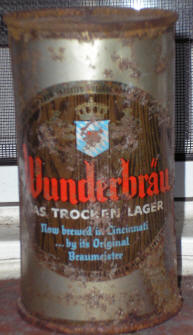 |
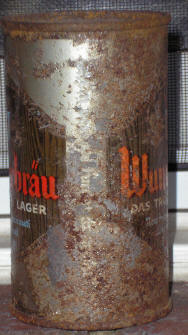 |
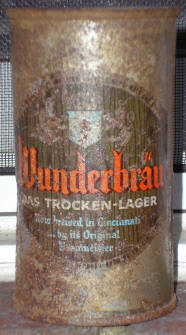 |
Wunderbrau was Red Top's final attempt to reverse their business decline. It was a darker "European style" beer. Yes, it's pretty darn rusty.
This month's can is a continuation of last month's. September Can-of-the-Month was a Prohibition-Era Red Top Malt Extract can, perfect for home baking brewing! This month it's a beer can from Red Top Brewing Company from near the end of its life.
Red Top Brewing
Last month's can-of-the-month page had the story of the Prohibition-era Red Top Malting Company. It was founded in 1904 as a company making malt syrup. Business was so good that they rented the closed Hauck Brewery as their new malt facility. When Prohibition ended in 1933 the Red Top Malt Company opened as a brewery, still using the old Hauck facility. The Hauck Company did consider restarting brewing. However, they remained uncertain and their old brewery was now leased by the Red Top Company which presented legal challenges. In April 1933, however, Red Top filed for a formal charter to use Hauck's facility as the Red Top Brewing Company. As a result, Hauck's management abandoned any ideas about reopening and Red Top began operation. In order to capitalize on those that fondly remembered the Hauck company, for several years Red Top noted on their labels that it was "Made in the Former Hauck Brewery" (see picture below).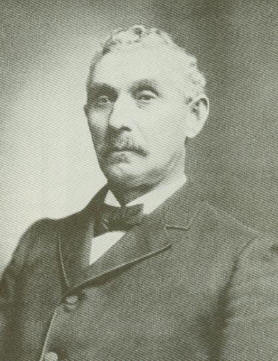 |
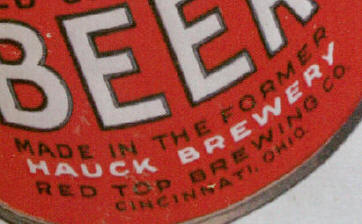 |
| John Hauck, circa 1890s? | A detail from a mid-1930s Red Top beer can. |
In 1936 Red Top announced that they were beginning a "doubling" program. It would double the production capacity at their Dayton Street plant including a new bottling unit, a new boiler, a new warehouse and other facilities. In January 1937, however, Cincinnati was hit by the worst flood in its history, reaching 80 feet over flood stage. On Sunday, January 24, 1937, before the water had even reached its peak, 10 oil tanks exploded and fires broke out over the city. A fifth of the city was covered by water, electricity was very limited and tap water was unavailable. Several breweries, including Red Top, were on higher ground, and so supplied water to the people of Cincinnati. Of course, other breweries did the same. Among the breweries which provided water were Red Top, Hudepohl, Burger, Clyffside, Delatron, and Bruckmann. The flooded breweries included Bavarian, Foss-Schneider, Heidelberg and Wiedemann.
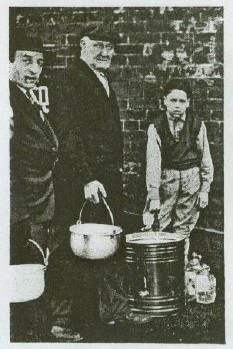 |
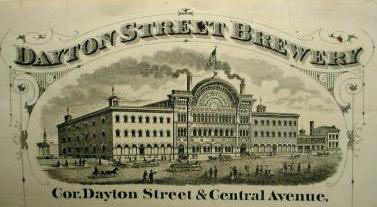 |
| People in Cincinnati line up at the Red Top Brewery to get water. | Hauck Brewery, circa 1880. |
Red Top was also one of the first breweries to start using cans. In August 1935, Red Top became the 6th brewer to use the new packaging after signing a contract with the National Can Company. National was the smallest of the 3 companies making beer cans at the time and they tended to sign smaller breweries as American and Continental can companies signed the biggest brewers. (The Red Top cans from National are very scarce today and valuable in good condition) Canning beer fit Red Top's expansion strategy along with increased production abilities and the increased brewery facility. They began expanding their sales area beyond Ohio into the South and east to the mid-Atlantic states.
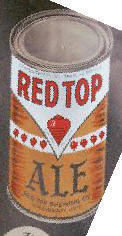 |
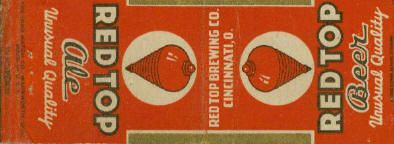 |
| A Red Top Ale can from a 1936 National Can ad | A Red Top Match book, 1940s??? |
World War II halted expansion for breweries nationwide as materials needed to brewing and selling beer were rationed. Like its competitors, Red Top promoted the war efforts in its ads, such as asking its customers to buy Savings Bonds, or asking them to buy quart bottles so as to save the metal used in making bottle caps, which were strictly rationed. After the war Red Top moved quickly to expand. In December 1945 they purchased the Clyffside Brewing Company for a little over one million dollars. This added 200,000 barrels a year to their brewing capacity along with additional storage space. They then expanded their new facility by another 50,000 barrel capacity.
In 1948-1949 the Dayton Street facility underwent another expansion creating 70,000 more square feet of floor space. A time capsule was placed in the cornerstone of the new addition. According to Tim Holian's Over the Barrel,
With this latest expansion Red Top had a capacity of over 2,000,000 cans and bottles a day making it Ohio's largest brewer and the 14th largest in the US. This proved to be the peak of Red Top's success. Pressure by the big nationals like Anheuser-Busch and Pabst was hurting every small and regional brewer, even one seemingly as successful as Red Top. In 1952 the brewery had made almost a million dollars in sales, but ended up with only about $200,000 in profit. In early 1954 it looked as if their profit would shrink even further. In May 1954 a new group of stockholder took over brewery operations. The new President of Red Top was former New York Yankee Tommy Henrich.
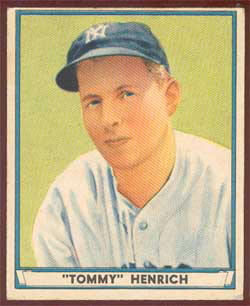 |
Tommy Henrich, about 1941.
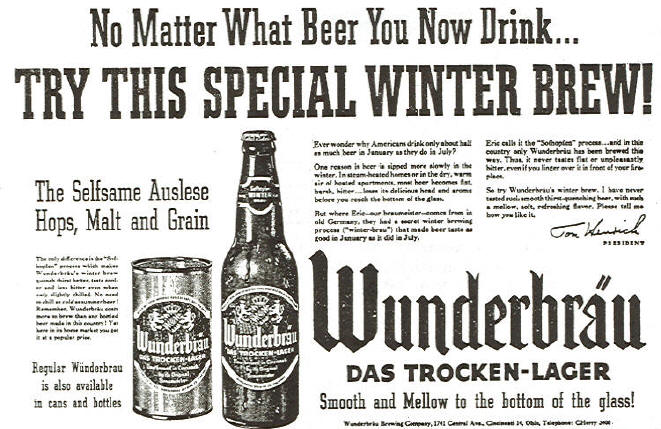 |
Wunderbrau advertisement, November 1954. Note Henrich's name and signature at the right.
Wunderbrau
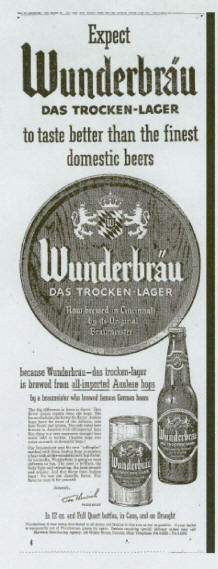 Wunderbrau newspaper ad, June 1954. |
Even as the brewery changed management, it was also introducing a new product, Wunderbrau Beer. It was a super-premium beer made with imported hops. Wunderbrau was intended to appeal to the more traditional beer drinker (who might not like the popular lighter beers) as well as to those who liked imported beers. The interesting thing about Wunderbrau is that it played up the traditional German angle in its marketing. Not only did it have a German name, but the beer's slogan, "Das Troken-Lager" (The Dry Lager) was in German. When World War Two was starting in Europe in the late 1930s a lot of beers in the US abandoned any reminders of any German origins. For example, one of Red Top's rivals in Cincinnati, Burger Beer, dropped the umlaut from its name. In 1954, however, the war was apparently enough in the past that brewers could again use German language and heritage in their marketing. Of course, Cincinnati had a large German population, so it made sense to use it in marketing in Red Top's home region anyway. The brewery even changed its name briefly to the Wunderbrau Brewing Company. Wunderbrau was an immediate success, but production lagged behind demand during the crucial summer months when beer sales are at their highest. When the fiscal year ended in March 1955, the brewery had lost a half million dollars. Another new buyer was sought for the company, and in August 1955 the Mack and Ullman families, that had founded the company in 1904 as the Red Top Malting Company, sold their stock to a group of Chicago and Cincinnati businessmen. The new managers decided to close the old Hauck facility that had been Red Top's since 1927, as it was too far outdated to be of any use. In February 1956 Henrich resigned and went back to TV and radio broadcasting. He must have seen that the brewery was still failing despite the efforts of the new owners. In August 1957 the brewery management announced that they were merging with Muskegon Motor Specialties Corporation, which made crankshafts. The Michigan company, however, only wanted to use Red Top's debt to lessen its own liabilities. They quickly turned around and announced that they had sold the brewery assets to Terra Haute Brewing. The last batch of Red Top in Cincinnati was produced on September 27, 1957. Terra Haute continued production of the brand for a short while, but it soon sold its interests to Atlantic Brewing Company in Chicago which also produced the beer. |
Brands Canned by Red Top
(additions and corrections welcome)Red Top Ale
Red Top Beer
Barbarossa
20 Grand Ale
Wunderbrau
Brewery Name Changes
(John) Hauck & (John) Windisch 1863-1879
John Hauck 1879-1881
John Hauck Brewing Company., Dayton Street Brewery 1881-1896
John Hauck Brewing Company 1896-1919
John Hauck Company (Prohibition) 1919-1927
Red Top Malting Company 1927-1933
Red Top Brewing Company 1933-1956
(aka Wunderbrau Brewing Company 1954-1955)
also at the former Clyffside Brewing Company 1933-1945
Red Top Brewing Company (Plant 2) 1945-1958
(aka Wunderbrau Brewing Company 1954-1955)
Sources Used:
Downard, William. Dictionary of the History of the American Brewing and Distilling Industries. (Westport, Conn. Greenwood Press, 1980)
Holian, Timothy. Over the Barrel: The Brewing History and Beer Culture of Cincinnati, Volume 2-Prohibition-2001. (St. Joseph, Mo.:Sudhaus Press; 2001) I can't say enough good things about Tim Holian's two volume history! It's well written, well-researched, and Dr. Holian had access to the Hudepohl-Schoenling archives!
Cincinnati Enquirer History of the 1937 Flood.
Meier, Norm. "The Red Top Years: A Historical Look Back" Beer Can Monthly
